Emu vs. Ostrich: 9 Key Differences Between These Giant Birds
Emus and ostriches are both flightless birds belonging to the family ratite. They are the largest living flightless birds, and thus are often confused.
It doesn’t help that they are so similar, with large eyes, charmingly dorky-looking faces, and long, slender necks and legs.
However, it’s not too difficult to tell these birds apart once you know what you’re looking for. They are different in size, color, habitat, and more. Even their eggs are much different to one another.
Learn everything there is to know about comparing these two birds below!
Comparing Ostrich vs Emu
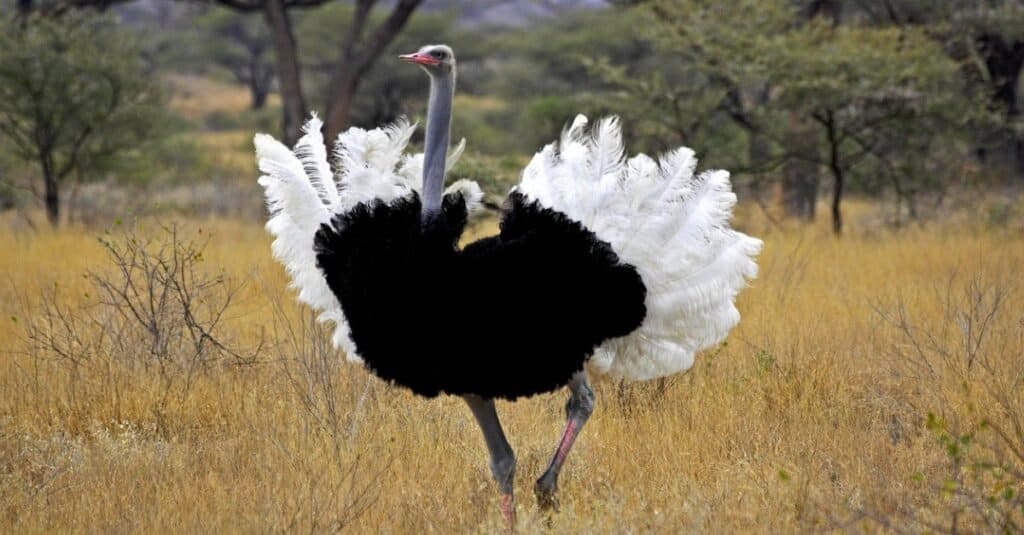
iStock.com/slowmotiongli
Ostriches and emus are very similar birds, but they do have vast differences. One of these is that there is only one emu species, while there are two different species of ostrich: the common ostrich and the Somali ostrich.
| Emu | Ostrich | |
| Size | Up to 7 feet tall and 150 pounds | Up to 9 feet tall and 320 pounds |
| Lifespan | 10-20 years | 30-50 years |
| Habitat | Australia | Africa |
| Wings | Small, discreet wings | Large wings with a maximum wingspan over 6 feet |
| Feet | 3 toes | 2 toes |
| Eggs | Dark green; 1-1.4 pounds | Cream; 3 pounds |
| Diet | Mostly herbivores | Omnivores |
| Speed | Up to 30 mph | Up to 45 mph |
| Color | Dark brown to black | Dark brown to back body with white patches. Usually pink or white on legs, face, and neck |
The 9 key Differences Between Ostriches and Emus
1. Ostriches are Much Larger
Emus are pretty big birds. They stand up to 7 feet tall and can weigh as much as 150 pounds. However, Ostriches get even larger!
Ostriches can grow up to 9 feet in height and weigh as much as 320 pounds.
2. Emus Live Shorter Lives
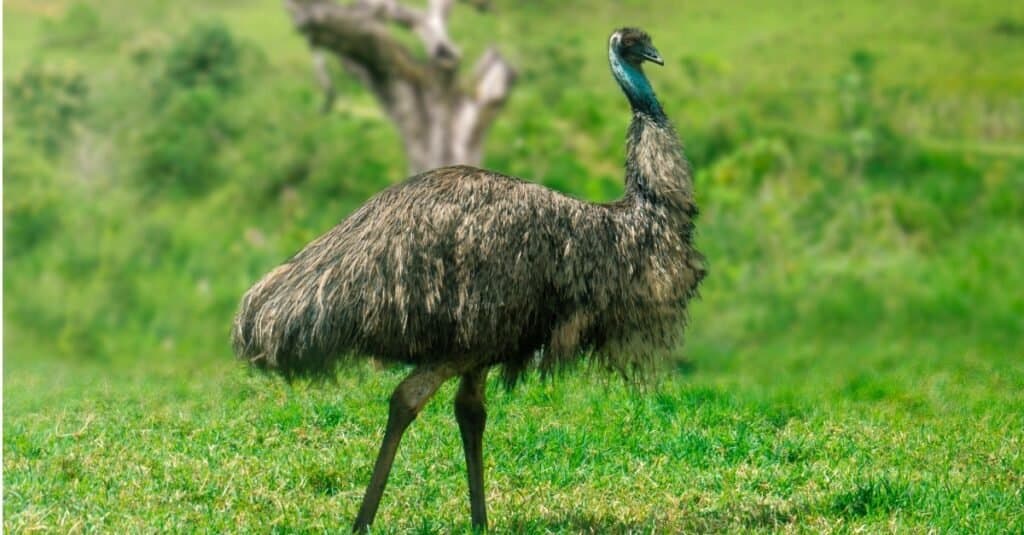
iStock.com/Gilnature
Unfortunately, emus only live around 10-20 years. The oldest emu ever recorded was 38 years old.
Ostriches, on the other hand, live very long lives of 30-50 years. In captivity, some ostriches live over 60 years.
3. They Live on Different Continents
Both of these flightless birds live in hot habitats, but they are in very different parts of the world. Ostriches live in the deserts of Africa, while emus live throughout most of Australia.
4. Emus have Smaller Wings
An emu’s wings are more difficult to spot than ostrich wings. One reason for this is their size: the emu’s wingspan is much smaller.
Coloration also plays a role. While ostriches often have white-tipped wings that contrast against their darkly-colored bodies, emu coloration is more consistent.
5. Ostriches Only have Two Toes on Each Foot
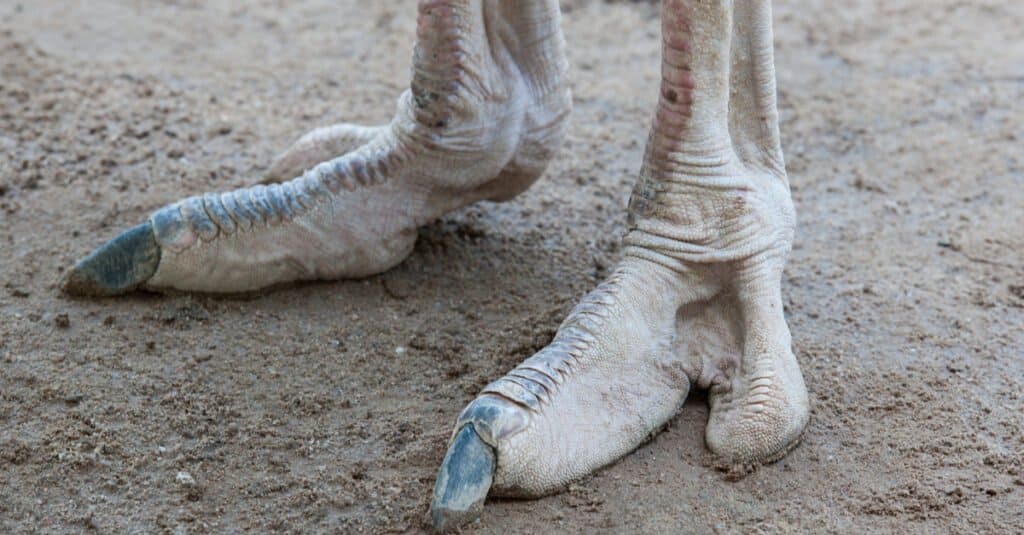
Ekkachai/Shutterstock.com
A unique trait of the ostrich is their two-toed feet. Most birds, including emus, have three toes per foot.
Ostrich feet are also designed for speed, with long tendons that allow them to run up to 45 miles per hour.
6. Emu Eggs are Smaller
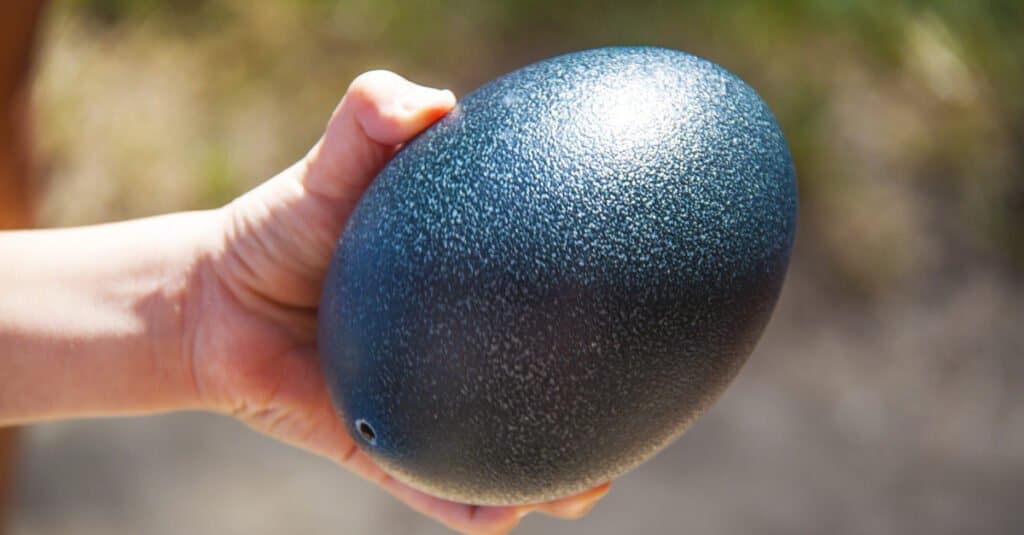
Alisa Burkovska/Shutterstock.com
If you are around a flightless bird who has just laid eggs, it will be incredibly easy to tell them apart by looking at the shells. Emu eggs are dark green in color and small, weighing around one pound.
Ostrich eggs are cream-colored and weigh up to three pounds.
7. Ostriches are Omnivores
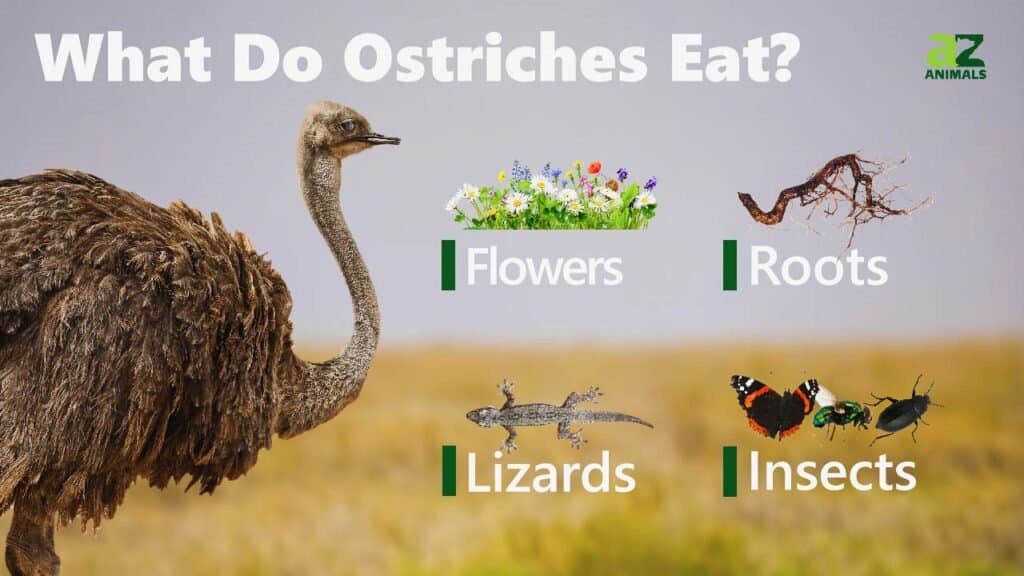
Ostriches eat mostly plants, but insects and small reptiles are also a part of their diet.
Emus are usually herbivores that eat seeds, fruits, and flowers. They may eat the occasional insect if the chance presents itself, however.
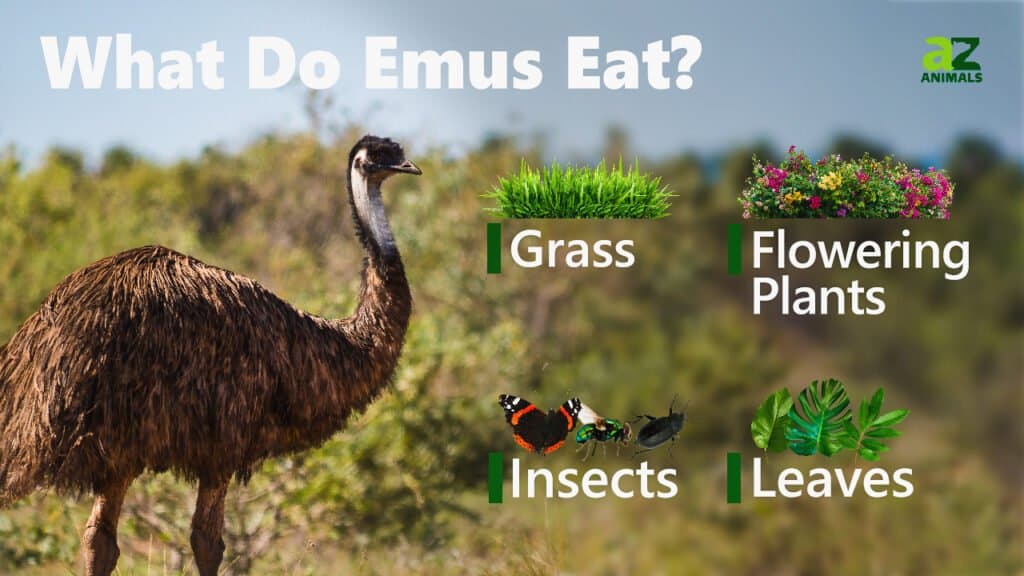
A-Z-Animals.com
8. Ostriches Run up to 45 Miles per Hour
Emus are a bit slower than ostriches, running at top speeds of 30 miles per hour. Ostriches have long tendons in their feet that allow them to run up to 45 miles per hour!
9. Emus are Darker in Color
As we discussed above, ostriches sometimes have white wing tips. They might also have white bellies. Emus, on the other hand, are dark all over.
Even their face, neck, and feet are darkly colored. Ostriches tend to have pink or white necks, faces, and feet by comparison.
More from A-Z Animals
Emus and ostriches are both flightless birds belonging to the family ratite. They are the largest living flightless birds, and thus are often confused.
It doesn’t help that they are so similar, with large eyes, charmingly dorky-looking faces, and long, slender necks and legs.
However, it’s not too difficult to tell these birds apart once you know what you’re looking for. They are different in size, color, habitat, and more. Even their eggs are much different to one another.
Learn everything there is to know about comparing these two birds below!
Comparing Ostrich vs Emu

iStock.com/slowmotiongli
Ostriches and emus are very similar birds, but they do have vast differences. One of these is that there is only one emu species, while there are two different species of ostrich: the common ostrich and the Somali ostrich.
| Emu | Ostrich | |
| Size | Up to 7 feet tall and 150 pounds | Up to 9 feet tall and 320 pounds |
| Lifespan | 10-20 years | 30-50 years |
| Habitat | Australia | Africa |
| Wings | Small, discreet wings | Large wings with a maximum wingspan over 6 feet |
| Feet | 3 toes | 2 toes |
| Eggs | Dark green; 1-1.4 pounds | Cream; 3 pounds |
| Diet | Mostly herbivores | Omnivores |
| Speed | Up to 30 mph | Up to 45 mph |
| Color | Dark brown to black | Dark brown to back body with white patches. Usually pink or white on legs, face, and neck |
The 9 key Differences Between Ostriches and Emus
1. Ostriches are Much Larger
Emus are pretty big birds. They stand up to 7 feet tall and can weigh as much as 150 pounds. However, Ostriches get even larger!
Ostriches can grow up to 9 feet in height and weigh as much as 320 pounds.
2. Emus Live Shorter Lives

iStock.com/Gilnature
Unfortunately, emus only live around 10-20 years. The oldest emu ever recorded was 38 years old.
Ostriches, on the other hand, live very long lives of 30-50 years. In captivity, some ostriches live over 60 years.
3. They Live on Different Continents
Both of these flightless birds live in hot habitats, but they are in very different parts of the world. Ostriches live in the deserts of Africa, while emus live throughout most of Australia.
4. Emus have Smaller Wings
An emu’s wings are more difficult to spot than ostrich wings. One reason for this is their size: the emu’s wingspan is much smaller.
Coloration also plays a role. While ostriches often have white-tipped wings that contrast against their darkly-colored bodies, emu coloration is more consistent.
5. Ostriches Only have Two Toes on Each Foot

Ekkachai/Shutterstock.com
A unique trait of the ostrich is their two-toed feet. Most birds, including emus, have three toes per foot.
Ostrich feet are also designed for speed, with long tendons that allow them to run up to 45 miles per hour.
6. Emu Eggs are Smaller

Alisa Burkovska/Shutterstock.com
If you are around a flightless bird who has just laid eggs, it will be incredibly easy to tell them apart by looking at the shells. Emu eggs are dark green in color and small, weighing around one pound.
Ostrich eggs are cream-colored and weigh up to three pounds.
7. Ostriches are Omnivores

Ostriches eat mostly plants, but insects and small reptiles are also a part of their diet.
Emus are usually herbivores that eat seeds, fruits, and flowers. They may eat the occasional insect if the chance presents itself, however.

A-Z-Animals.com
8. Ostriches Run up to 45 Miles per Hour
Emus are a bit slower than ostriches, running at top speeds of 30 miles per hour. Ostriches have long tendons in their feet that allow them to run up to 45 miles per hour!
9. Emus are Darker in Color
As we discussed above, ostriches sometimes have white wing tips. They might also have white bellies. Emus, on the other hand, are dark all over.
Even their face, neck, and feet are darkly colored. Ostriches tend to have pink or white necks, faces, and feet by comparison.






